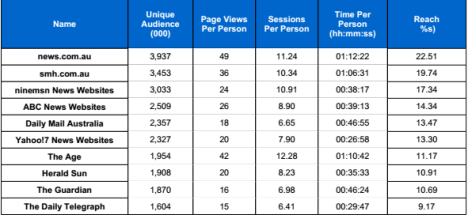More record audiences for online news sites in July
The Daily Mail Australia has crept another place up the Nielsen Online rankings, overtaking Yahoo!7’s digital assets and adding another 23,000 readers in July from June.
News.com.au extended its lead at the top of the table with a unique audience of 3.937m readers, it’s biggest ever audience, which Nielsen says gives it an audience reach of 22.51 per cent. Smh.com.au dropped slightly but maintained second place with 3.453m, whilst Ninemsn’s suite of sites is third with 3.033m readers, with the site continuing as the logoff page for the Microsoft Outlook email service.
July saw a series of high-profile news events including the shooting down of Malaysian Airlines plane MH17 over the Ukraine, fresh conflict in Gaza and a number of sporting events including the FIFA World Cup final and Tour de France.



Where’s the Australian on your list?
“Ninemsn’s suite of sites is third with 3.033m readers, with the site continuing as the logoff page for the Microsoft Outlook email service.”
This is false. Outlook redirects to the ninemsn Homepage, who’s UA’s are not included in the News “suite of sites” nor the top ten ranking.
I’m curious why the Age website does comparatively poorly relative to its stable mate The Sydney Morning Herald online, but comparatively well for print sales. When you look at daily sales of physical papers, SMH sold 126,000 in the March quarter; the Age was at 118,000. SMH is 7% ahead. Online the gap is 77% for July.
The population of NSW is about 28% greater than Victoria’s; the population of Sydney is about 10% more than Melbourne. Perhaps the difference between print sales can be mostly explained by the size of the cities, as I presume that this is the area where most print copies are sold. Once you get into regional areas, I’m guessing people are less interested in paying for metro-focused content. I’m also guessing that non-capital city folk are happy enough reading the online equivalent because it is free, so suggest that the state population numbers might be a better guide to potential readership.
The SMH has a much larger non-capital city pool of potential readers, but that doesn’t explain why its online readership is 77% greater than the Age.
Are there other factors? Do other Fairfax assets or Google News tend to redirect to the SMH rather tha the Age?
Yes, KF, you’re on the money with the last one.